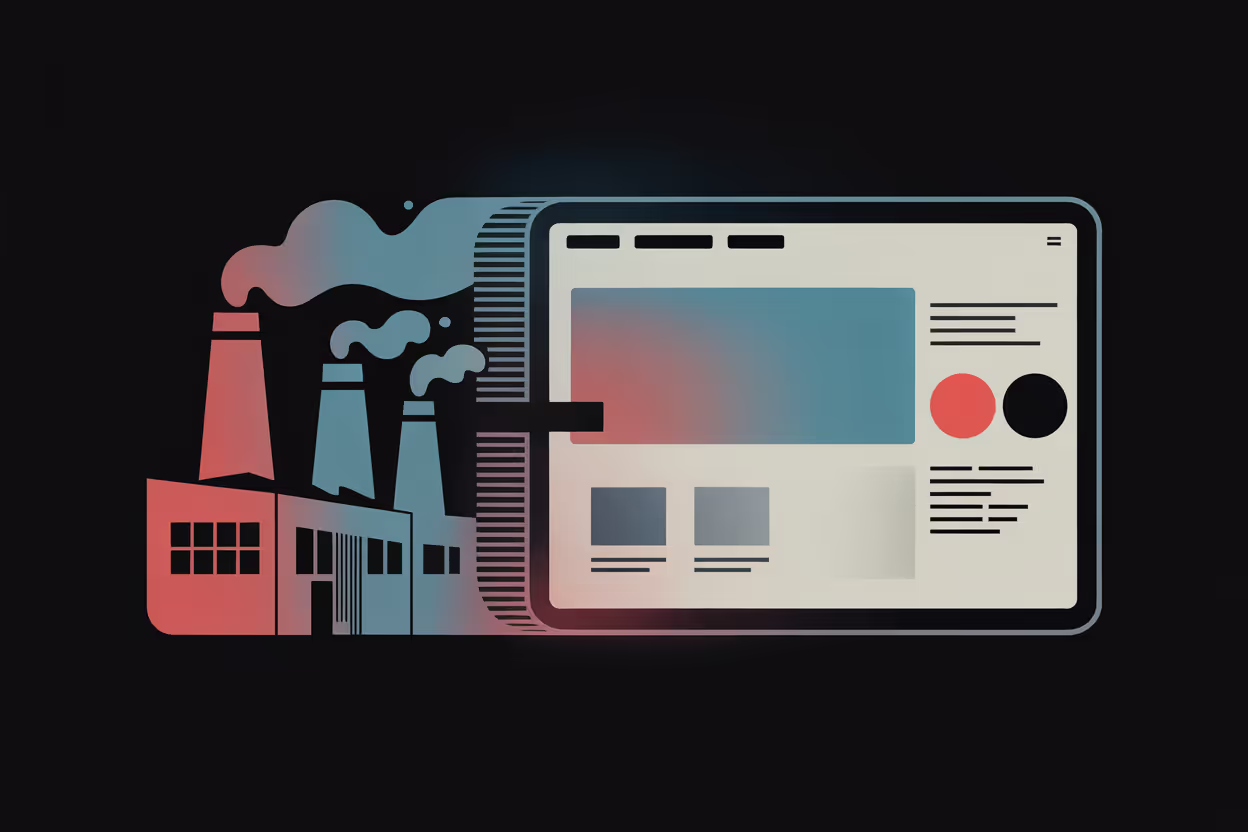Your manufacturing company makes incredible products. But if your website can't explain what you do in the first 10 seconds, you're losing customers to competitors who can.
We get it. Manufacturing is complex. Your buyers are sophisticated professionals who need detailed information before they'll even consider talking to you. The stakes are high when a single order could mean hundreds of thousands of dollars and months of production time. One wrong decision on their part could shut down their entire operation.
This guide will show you exactly how to build a manufacturing website that turns those cautious, research-heavy visitors into qualified leads who are ready to work with you. We're not talking about pretty pictures and fancy animations. We're talking about websites that actually work for manufacturers.
What makes this guide different is that it's based on what actually works in the real world. After building over 185 B2B websites, we've learned what manufacturing buyers really need from your website. Not what we think they need, but what they actually look for, click on, and respond to.
You'll learn everything from how to structure your site for different types of buyers to the specific content that converts visitors into customers. We'll cover:
- Technical foundations that matter
- Interactive tools that generate leads
- Common mistakes that make manufacturers invisible online
By the end, you'll know exactly what your website needs to compete and win.
Why Manufacturing Websites Are Different
Your Buyers Think Differently
Manufacturing buyers aren't impulse shoppers.
- Engineers need detailed specifications before they'll even consider your products
- Purchasing managers need to understand your pricing flexibility and payment terms
- Executives need to see the ROI and strategic value of working with you
The research phase for manufacturing purchases often stretches 6–12 months. Your buyers are comparing multiple suppliers, gathering internal approvals, and building consensus among teams. Each person in that chain has different priorities and concerns. Your website needs to speak to all of them.
Plex: Tailoring Navigation to Buyer Needs
Smart manufacturing platform Plex demonstrates how thoughtful navigation can address the diverse priorities of buyers. Visitors can select their industry (e.g. aerospace, automotive and tire, industrial manufacturing, etc.) to be directed to content specifically relevant to their sector.

This industry-focused approach helps Plex deliver a more relevant experience, ensuring different types of buyers quickly access the information most applicable to their business.
Your Products Are Complex
You can't just show a product photo with a price tag and an "Add to Cart" button. Custom manufacturing means you might have infinite variations of what you can produce. The technical specifications that seem boring to outsiders are absolutely critical to your buyers.
Your website needs to:
- Communicate capabilities, not just products
- Show processes, not just outcomes
- Prove expertise through technical depth (while still being accessible to non-technical decision-makers)
The Anatomy of a High-Converting Manufacturing Website
Homepage Essentials
Your homepage has about 10 seconds to answer three questions:
- What do you make?
- Who do you serve?
- Why should someone choose you over the dozen other suppliers they're researching?
Clear Market Segmentation
The best manufacturing homepages don't try to be everything to everyone. They segment visitors quickly and guide them to relevant information. Clear navigation helps different types of visitors find what they need without getting lost in technical details they don't understand.
For example, B2B glass contractor Rice Lake Glass immediately segments visitors by market. The site’s navigation menu clearly distinguishes between “commercial” and “residential” buyers, with each link directing users to content tailored specifically to their needs.
The homepage also allows visitors to switch between “commercial” and “residential” tabs. Each offers a concise overview of relevant services along with bullet points highlighting the types of glass installation available.
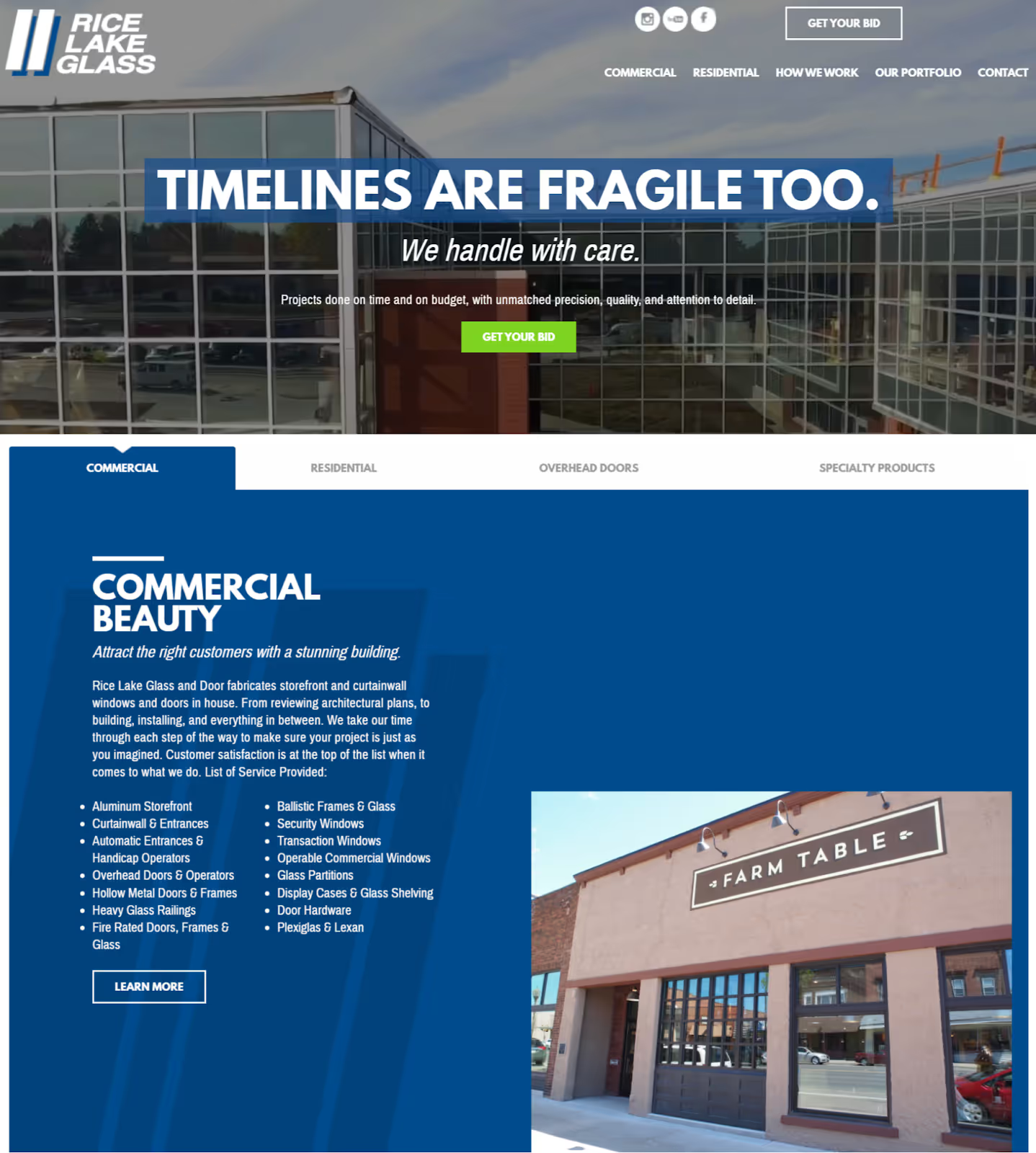
By segmenting visitors from the start, Rice Lake Glass ensures a more relevant and efficient browsing experience, helping buyers quickly find the information that matters most to them.
Trust Signals and Social Proof
Trust signals are also essential, and they belong front and center on your homepage. When someone chooses a manufacturing supplier, they're betting their reputation on your ability to deliver. One late shipment, one quality issue, one communication breakdown, and their entire production line could grind to a halt. That's why trust signals and social proof aren't just nice to have on your website. They’re crucial.
Social proof and B2B trust signals include:
- Industry certifications
- Years in business
- Logos of companies everyone recognizes
- Quality standards
- Client testimonials
- Facility photos
- Team credentials
Remember: these aren't decorative elements. They're the proof points that help nervous buyers feel confident about choosing you. These trust signals tell visitors they're in the right place before they even start exploring. Your manufacturing website needs to build trust at every step.
Core Pages Every Manufacturing Site Needs
Your website needs specific pages that manufacturing buyers expect to find, including:
- Capabilities Pages: Explain what you can actually do, not just what you sell
- Industry Pages: Prove you understand specific challenges in aerospace versus automotive versus medical devices
- Supply Chain Transparency Pages: Help procurement teams feel confident by showing delivery performance and lead times
- Resource Pages: Technical guides, specification sheets, and case studies matter more than you think to help buyers build internal consensus
- About Page: People still buy from people, so show your facility, your team, and your story
- Contact Page: Feature multiple contact options to let visitors engage however they're comfortable, whether that's an RFQ form, direct phone line, or chat
The Pages Most Manufacturers Miss
Here’s what many manufacturing websites overlook:
- Application and Use Case Pages: Show how your products solve real problems
- Process Pages: Help buyers understand what to expect by explaining how you work
- Quality and Testing Information Pages: Prove you take standards seriously
- Sustainability Pages: Show your environmental commitments—this matters more every year
- News and Updates Pages: Prove you're active, growing, and investing in your business
Many of these pages won’t drive direct conversions, but they build the trust that makes conversions possible.
Understanding Your Three Key Buyers
Here’s what you should know about technical, economic, and executive buyers.
The Technical Buyer
Engineers and technical specialists need hard data, including:
- Detailed specifications, tolerances, and material certifications
- CAD downloads and technical documentation
- Testing data and quality reports
Marketing language actually hurts you with these buyers. They want accuracy and precision. If you claim "high precision manufacturing" without specifying actual tolerances, they'll assume you don't really understand precision. Specific technical details build credibility with this audience.
The Economic Buyer
Purchasing managers and procurement specialists focus on different concerns. They need to understand the elements of your business that directly impact their planning, like:
- Pricing structures
- Payment terms
- Minimum order quantities
- Lead times
- Proof of supply chain reliability
- Vendor certifications
These buyers often handle multiple product categories and suppliers. They might not understand the technical details of what you make, but they understand delivery performance, quality metrics, and total cost of ownership. Your website needs to speak their language too.
The Executive Buyer
Decision-makers and executives look at the bigger picture. They want to know if you can be a strategic partner, not just a vendor. They need to see the ROI of working with you. They look for signs of innovation and stability.
Elements that matter to these buyers include:
- Industry recognition
- Growth indicators
- Strategic vision
Executives want to work with suppliers who will still be thriving in five years. Your website needs to convey strength and forward momentum, not just current capabilities.
Streamlined Navigation for Different Buyer Types
Graco, a leading supplier of fluid management products and packages, features a well-organized mega menu that helps different user types navigate its extensive product catalog. Visitors who click the “Products” link in the main navigation see offerings segmented by type: homeowner, contractor, service & repair, or manufacturing. Each category is further divided to guide potential buyers directly to the products they need, while a “View All Products” option provides a quick overview of the entire catalog.

This clear, structured navigation reduces friction and ensures different types of buyers can find relevant products efficiently, improving both the experience and conversion potential.
Related Resources:
- B2B Buyer Journey Mapping: Building Websites That Convert
- B2B Website Navigation: Structure That Guides Complex Buyers
Content That Converts Manufacturing Visitors
Stop Talking About Yourself
Most manufacturing websites make the same mistake. They lead with their equipment list, their certifications, and their history. But your visitors don't care about you yet. They care about their problems and whether you can solve them.
- Instead of "We have five CNC machines" → Try "Complex aerospace parts machined to your exact specifications"
- Instead of "Family-owned since 1987" → Try "Delivering critical components on time for 35 years"
See the difference? One talks about you. The other talks about what you do for them.
The Power of Specificity
Vague claims destroy credibility with technical buyers. "Precision machining" could mean anything. "CNC milling of aerospace aluminum parts to ±0.0001 inch tolerance" means exactly what you can do.
Real examples beat generic descriptions every time. Instead of saying you serve the automotive industry, explain that you manufacture brake system components for three of the top five automotive OEMs. Specificity builds trust and helps the right buyers self-qualify.
Case Studies That Actually Sell
Good case studies follow a simple formula:
- Start with the specific problem your customer faced, including numbers whenever possible
- Next, explain your unique approach to solving it
- Finally, share measurable results that other customers can relate to, including why they chose you over competitors
The best case studies feel like stories, not sales pitches. They help prospects envision working with you. They prove you've solved similar problems before. They give nervous buyers confidence that you can deliver.
Technical Content That Builds Trust
Technical content serves two key purposes:
- It helps buyers during their research phase, providing value before they're ready to talk
- It gives champions within their organization ammunition to sell your solution internally
Offer technical content like:
- White papers and technical guides that position you as an expert
- Process documentation that shows transparency
- Testing and quality reports that prove your commitment to standards
- Sustainability initiatives and certifications that show you care about your impact on the environment
Visual Communication for Complex Products
Beyond Static Photos
Static product photos don't tell the whole story for complex manufactured products. Be sure to incorporate:
- 3D models that visitors can rotate and explore to help them understand what you actually make
- Interactive product configurators that let prospects see possibilities
- Process videos that demonstrate capabilities better than any description could
- Virtual facility tours that build trust by showing your actual operation
Buyers want to see clean, organized, modern facilities. They want to see your equipment in action. They want to see real people doing real work.
An Interactive Product Visualization from Emerson
Global B2B technology and engineering company Emerson offers 3D product viewers for many of its solutions, including an interactive model of their Fisher FIELDVUE 4400 Digital Position Transmitter. Visitors can rotate the transmitter to view every component, zoom to see enlarged detail, and click on individual parts to learn their function and purpose.

This immersive product configurator helps buyers visualize how the product works in real-world applications, deepening their understanding and confidence before purchase.
Making Technical Information Visual
Infographics can explain complex processes better than paragraphs of text. Consider offering:
- Before and after comparisons that show the value you create
- Animated diagrams that walk through multi-step manufacturing processes
- Interactive specification charts that let buyers compare options
These visual tools serve different audiences simultaneously. Engineers get the technical details they need. Non-technical stakeholders can understand the basic concept. Everyone moves forward with shared understanding.
Video Content That Converts
Different types of videos serve different purposes:
- Facility walkthrough videos build trust and credibility
- Process demonstration videos prove capabilities
- Customer testimonial videos provide social proof
- Technical explainer videos educate and position expertise
The key is matching video content to buyer needs at different stages. Early researchers might watch educational videos. Serious buyers want to see your facility and capabilities. Final decision makers might need customer success stories.
Interactive Tools That Generate Leads
Product Configurators
Product configurators do more than show options. They let visitors build their custom solution while you capture valuable information about their needs. When someone spends time configuring a product, they're showing serious interest. That's a hot lead.
The best configurators:
- Show real-time pricing when possible
- Generate PDF specifications that visitors can share with their team
Product configurations that include these elements naturally lead to quote requests with specifications already captured. They qualify leads while providing value.
Calculators and Estimators
ROI calculators help buyers build the business case internally. Material weight calculators and lead time estimators answer common questions without phone calls. Cost comparison tools position your value against alternatives.
These tools serve additional purposes as well, like:
- Providing immediate value to visitors
- Positioning your expertise
- Capturing information about what buyers actually need
- Generating qualified leads who have already invested time with your brand
Mistake Cost Calculator: An Interactive Tool That Provides Real Value
Arena features a “Cost of Mistakes” calculator that enables prospects to input their business details, select a challenge, and instantly see the real-world cost implications. This interactive tool helps buyers understand how much product development mistakes truly cost, ultimately persuading them to consider Arena’s cloud-native solutions as a way to prevent those losses.
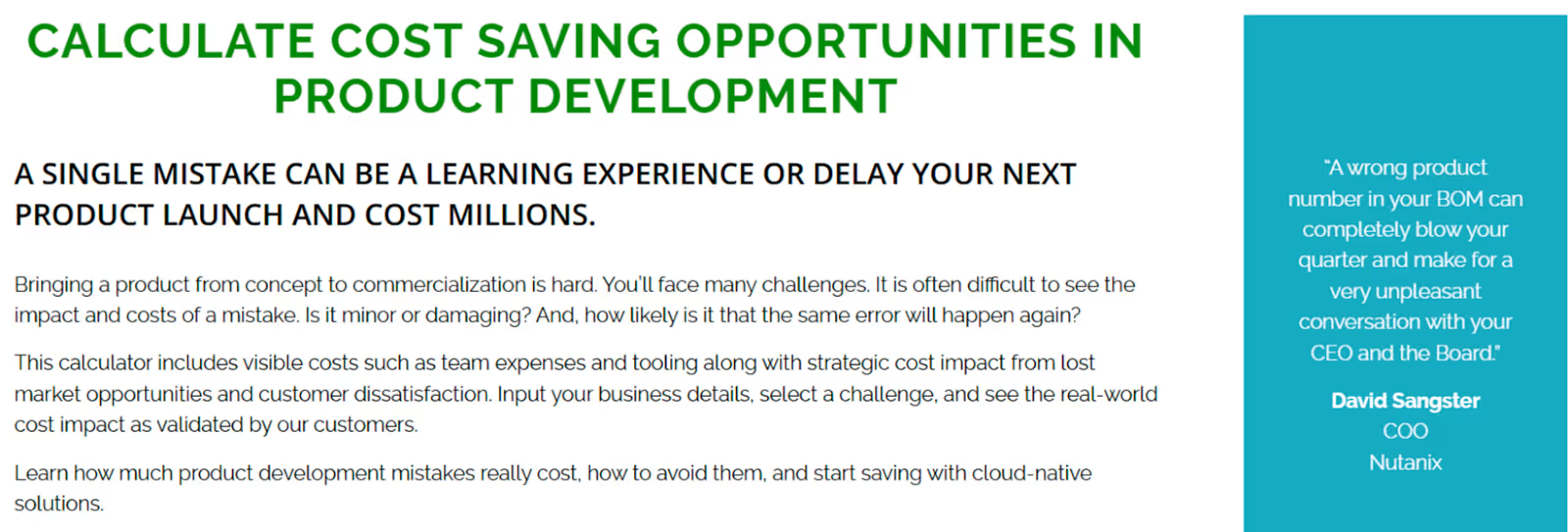
Here’s what their calculator looks like:
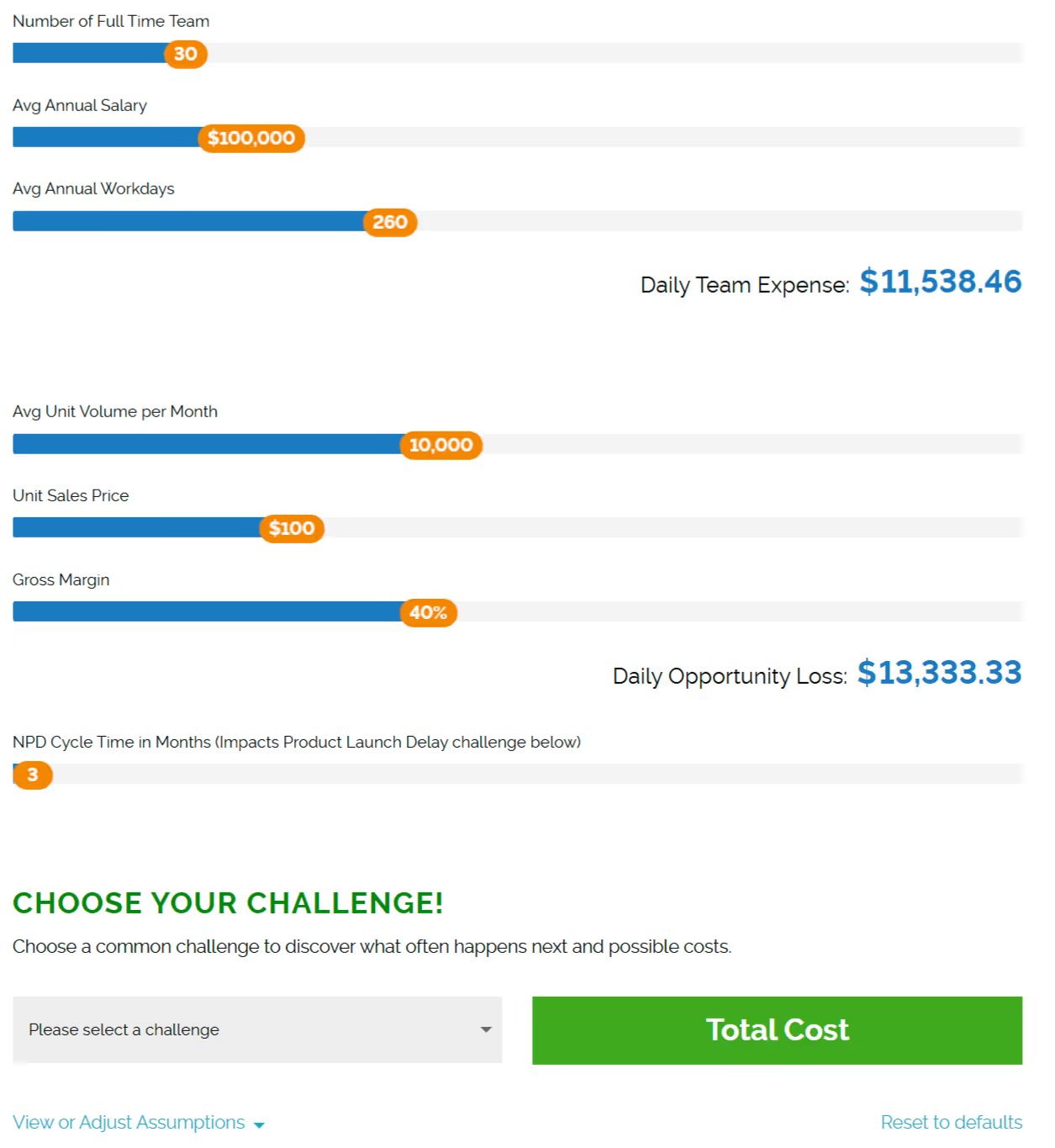
Prospects can input factors like their number of full-time team members, average unit volume per month, and gross margin to uncover their daily team expense and opportunity loss. Toward the bottom, they can select a common challenge like “data errors” or “customer complaints” to further personalize the loss.
By turning abstract pain points into measurable business impact, Arena transforms data into a powerful motivator for action.
Self-Service Resources
Offering self-service resources is also important for showing confidence in your products. These might include:
- Downloadable CAD files that save engineers time
- Specification sheet builders that let buyers create custom documentation
- Comparison tools that help them evaluate options
- Compatibility checkers that prevent ordering mistakes
Valuable resources like these:
- Reduce friction in the buying process
- Position you as transparent and helpful
- Capture contact information from serious buyers willing to provide it in exchange for value
Choosing the Right Platform
Webflow for Manufacturing Sites
Webflow has become increasingly popular for manufacturing websites, and for good reason.
The Pros
Here’s what makes Webflow stand out for manufacturers focused on performance and ease of use:
- The visual development environment means you can create sophisticated designs without coding limitations
- The built-in content management system handles product catalogs and case studies elegantly
- Your marketing team can make updates without waiting for developers
- Performance comes built in with Webflow's hosting infrastructure
- SEO capabilities are strong with clean code output and easy meta tag management
The Cons
Webflow doesn’t offer as much flexibility as some alternatives:
- Connecting to niche manufacturing ERP or specialized CRM systems may require third-party tools or custom API integrations
- Advanced user permissions and multi-stage approval workflows are more limited than many enterprise CMS platforms
Consider Webflow if…
You’re a manufacturer wanting professional results without enterprise software costs. Webflow is often the sweet spot.
Craft CMS Alternative
Some manufacturers choose Craft CMS because they need more flexibility than Webflow provides.
The Pros
Craft offers more options for complex custom functionality:
- Companies with in-house development teams can build exactly what they need
- Multi-site capabilities and localization features serve global manufacturers well
The Cons
The tradeoff is complexity and maintenance:
- Craft requires more technical expertise to manage
- Updates and changes typically need developer involvement
Consider Craft CMS if…
Your company has specific technical requirements. The flexibility might be worth it.
Other Platform Considerations
Other solid platforms include:
- WordPress: WordPress powers a huge portion of the web, but requires careful maintenance and security updates
- HubSpot CMS: HubSpot makes sense if you're already invested in their CRM and marketing tools
Your team's technical expertise should guide your platform choice. Long-term maintenance requirements matter as much as initial capabilities.
Technical Foundation and Compliance
Speed and Performance
Manufacturing websites tend to be heavy with images, PDFs, and technical documentation. All that content can slow things down if not handled properly. Global visitors need fast load times regardless of their location. Mobile performance matters more than many manufacturers realize.
Your site needs to perform well on every device. Mobile speed appeals to field sales teams that need access during trade shows, engineers researching from job sites, and executives reviewing materials between meetings.
A Case Study in Seamless Design: Airbus A220-300
Multinational aerospace company Airbus offers a clean, sleek website that loads instantly, features vibrant product imagery, and seamlessly integrates technical content and specifications without overwhelming the user experience.
For example, the company’s “A220-300” page loads in a split second, immediately drawing attention to the aircraft’s streamlined design and impressive performance. Just below the fold, the page presents key statistics highlighting the A220-300’s lower operating costs per seat, lower fuel burn, and extended range. These quick, digestible facts speak directly to B2B buyers who value measurable efficiency and cost savings.

Next, an interactive global map invites users to select a departure airport to visualize how far the A220-300 can fly. This engaging feature connects technical data to real-world applications.

As visitors scroll, a video begins playing automatically, showcasing the aircraft cabin’s spacious seating, large windows, and customizable mood lighting. The video loads instantly with no lag, and a pause option allows viewers to control their experience without distraction.
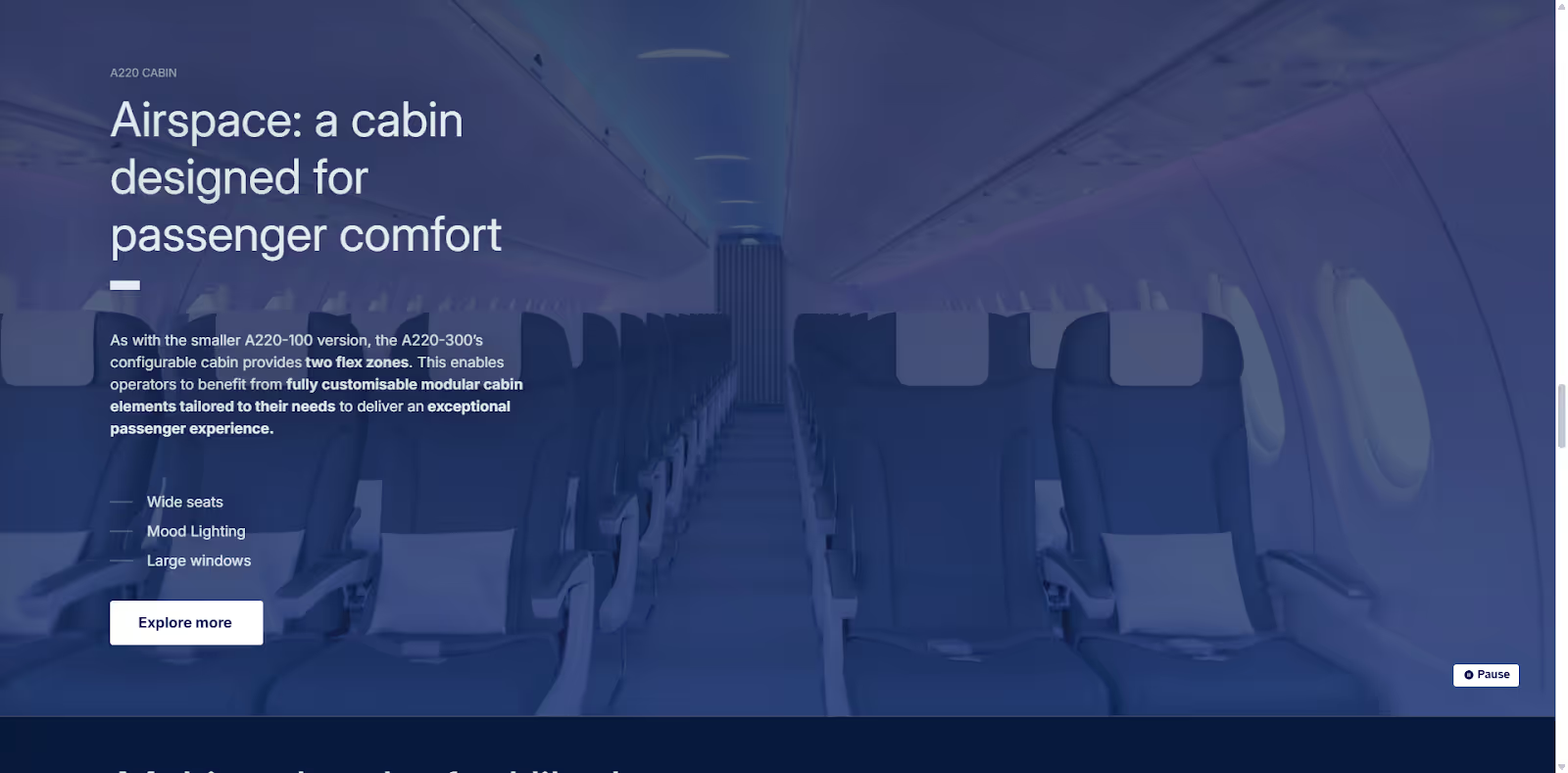
For stakeholders looking for technical specifications, the “Key figures” section clearly outlines capacity, performance, and dimensions. The ability to toggle between metric and imperial units ensures usability for a global audience.
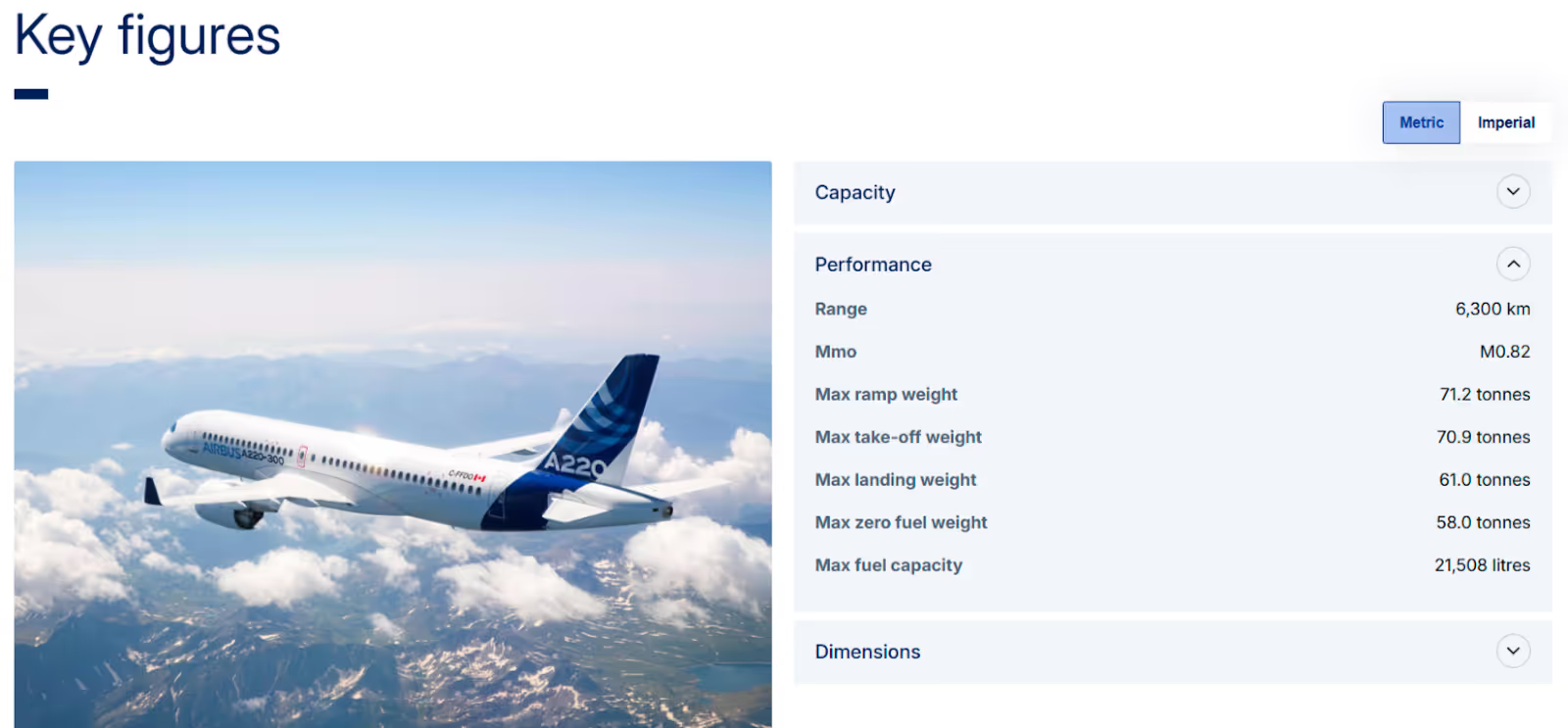
The page concludes with a concise FAQ section providing quick answers to common questions. This is followed by a “Contact us” button for users who didn’t find the information they needed—or who are ready to take the next step.

Airbus’ product page demonstrates how manufacturers can combine speed, performance, visual appeal, interactivity, and technical depth to create a user experience that informs, engages, and converts.
Search Engine Optimization Basics
Manufacturing SEO is unique. People search for specific part numbers. They look for local manufacturing capabilities. They use highly technical terminology. They type in long, specific queries that might only get a few searches per month but represent high-value opportunities.
Your site structure needs to support these varied search patterns by including:
- Product pages with proper schema markup
- Local SEO (crucial for regional manufacturers)
- Technical content that is crawlable and indexable despite its complexity
Accessibility and Legal Compliance
Web accessibility isn't optional anymore. WCAG 2.1 Level AA standards ensure everyone can use your site. Proper alt text for images, sufficient color contrast, and keyboard navigation aren't just nice to have. They're legally required in many situations.
Manufacturing has additional compliance considerations. For example:
- ITAR restrictions affect defense contractors
- FDA requirements impact medical device manufacturers
Your website needs to meet industry-specific security and privacy standards.
Security and Industry Requirements
Every page needs SSL encryption, not just contact forms. RFQ forms must securely handle customer data and technical drawings.
Some industries require specific security certifications for suppliers. Your website security reflects your overall approach to customer protection.
Related Resources:
- Web Accessibility in Georgia: Practical Compliance for B2B Sites
- B2B Website Design Best Practices: The Complete Guide
Lead Generation That Actually Works
Beyond the Basic Contact Form
Each form type serves different visitor needs:
- Smart RFQ forms qualify leads by asking the right questions upfront
- File upload capabilities let engineers share technical drawings
- Quote configurators provide instant estimates for standard products
- Sample request forms capture interest from buyers still researching
The key is providing options without overwhelming choices. Clear labels and expectations help visitors choose the right path. Progressive disclosure keeps forms from feeling overwhelming.
High-Value Content Offers
The best content offers solve real problems for your buyers and are substantial enough to warrant contact information. They're specific enough to attract qualified prospects. They provide immediate value while showcasing your expertise.
Here are some examples:
- Technical specification guides deliver essential details to help buyers evaluate product fit and performance
- Industry comparison charts help them evaluate options
- Webinars on manufacturing trends position thought leadership
- Virtual lunch-and-learns build relationships before sales conversations
Video and Webinars for Manufacturing
Videos and webinars are powerful tools for educating, engaging, and converting potential buyers.
- Technical training sessions help customers succeed with your products
- New capability demonstrations generate interest in expanded services
- Industry trend discussions position expertise
- Q&A sessions with engineers build trust and accessibility
Live events create urgency and engagement, while recorded sessions provide ongoing value. Both formats capture qualified leads while building relationships.
Building Trust Before Contact
Trust building starts long before a prospect reaches out. These strategies help establish credibility and accessibility from the start:
- Live chat for technical questions shows you're accessible and helpful
- Clear response time expectations set proper boundaries
- Multiple contact methods accommodate different preferences
- Direct phone numbers build trust better than forms alone
The goal is reducing friction while maintaining lead quality. Make it easy for serious buyers to reach you. Give researchers ways to learn more without commitment. Balance accessibility with practical business needs.
Related Resources:
Common Manufacturing Website Mistakes
Mistake #1: The "We Do Everything" Trap
Many manufacturers try to appeal to everyone and end up appealing to no one. Claiming expertise in everything from aerospace to agriculture makes buyers skeptical. Jack of all trades positioning suggests master of none.
It's better to own a specific niche than be vague about everything. Your website should clearly communicate what you're best at. Let competitors have the business you don't really want. Focus wins over breadth online.
Mistake #2: Hiding Behind the RFQ Form
Not every visitor is ready to request a quote on their first visit. Demanding contact information too early drives people away. Education and value need to come before sales conversations.
Provide multiple ways to engage at different commitment levels. Some visitors want to download a guide. Others want to watch a video. Some might start with live chat. Give them options.
Mistake #3: Ignoring Mobile Visitors
Field technicians check product specifications on-site. Project managers review timelines during plant walkthroughs. Operations leaders analyze reports between strategy sessions.
Your mobile experience needs full functionality, not just responsive design. Make sure your:
- Forms work
- Documents are downloadable
- Navigation makes sense on smaller screens
Mistake #4: Set-It-and-Forget-It Syndrome
Outdated certifications destroy trust instantly. Old equipment lists suggest lack of investment. Stale news sections make you look inactive. Missing accessibility features risk legal issues and lost customers.
Your website needs regular attention and updates, including:
- Fresh case studies to prove ongoing success
- Current certifications to maintain credibility
- Active news sections to show growth and investment
Measuring and Optimizing Performance
Key Metrics for Manufacturing Sites
Here are the metrics that actually matter for manufacturing websites:
- Qualified lead percentage versus total form submissions
- Time spent on technical specification pages
- CAD file and technical document downloads
- RFQ form completion rates
- Industry and company size of your visitors
These metrics tell you if you're attracting the right audience and providing what they need. Volume matters less than quality in B2B manufacturing.
Testing What Works
A/B testing helps optimize what matters.
- Try different headlines for different industries
- Test form length against conversion rates
- Compare video content versus static images for engagement
- Test different calls-to-action for various audience segments
Small improvements compound over time. A better headline might increase conversions by 10%. A cleaner form might add another 15%. These gains add up to significant business impact.
Monthly Review Checklist
Regular reviews keep your site performing. Ask yourself:
- Which industries visit most often?
- What content drives qualified leads?
- Where do visitors drop off in the conversion process?
- Which traffic sources bring quality prospects versus tire kickers?
Understanding these patterns helps you make informed improvements. Maybe you need more content for a growing industry segment. Perhaps certain pages need technical updates. Regular reviews catch issues before they become problems.
Your Next Steps
Start With These Three Things
Here's where to begin improving your manufacturing website today:
- Fix your homepage messaging to pass the 10-second test
- Create one detailed capability page that truly explains what you do
- Add one strong case study with real numbers and specific results
These improvements will show immediate impact. They don't require a full redesign. They can be done with your current website. Start here and build momentum.
When to Consider a Redesign
Sometimes incremental improvements aren't enough. Consider a full B2B website redesign if:
- Your site is over four years old
- You can't update content without a developer
- Mobile visitors can't navigate effectively
- You're consistently losing to competitors with better web presence
A redesign is a significant investment. But if these issues are costing you business, the ROI justifies the cost.
The Investment Question
Quality manufacturing websites require real investment. But they pay for themselves quickly. One new customer relationship could cover the entire cost. A steady stream of qualified leads transforms your business.
Think about your website as manufacturing equipment. You wouldn't run production on outdated machines. Your digital presence deserves the same strategic investment as your physical capabilities.
Final Thoughts
Your website is often the first impression potential customers have of your company. In manufacturing, where trust is everything, that first impression matters enormously. Make sure your digital presence matches the quality of your production.
Your website should make prospects confident they're dealing with a professional, capable, trustworthy manufacturer. It should answer their questions, address their concerns, and make it easy to take the next step. When it does all that, it becomes your most powerful sales tool.
Get this right, and your website will work as hard as you do. It will qualify leads while you sleep. It will answer questions while you're on the shop floor. It will build trust before you ever talk to a prospect. That's the power of great manufacturing website design.
